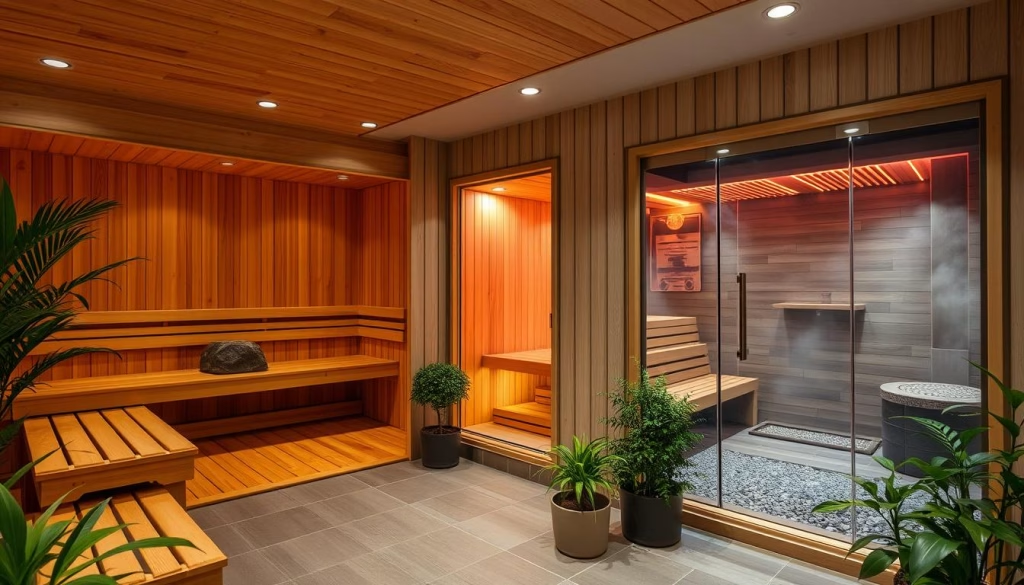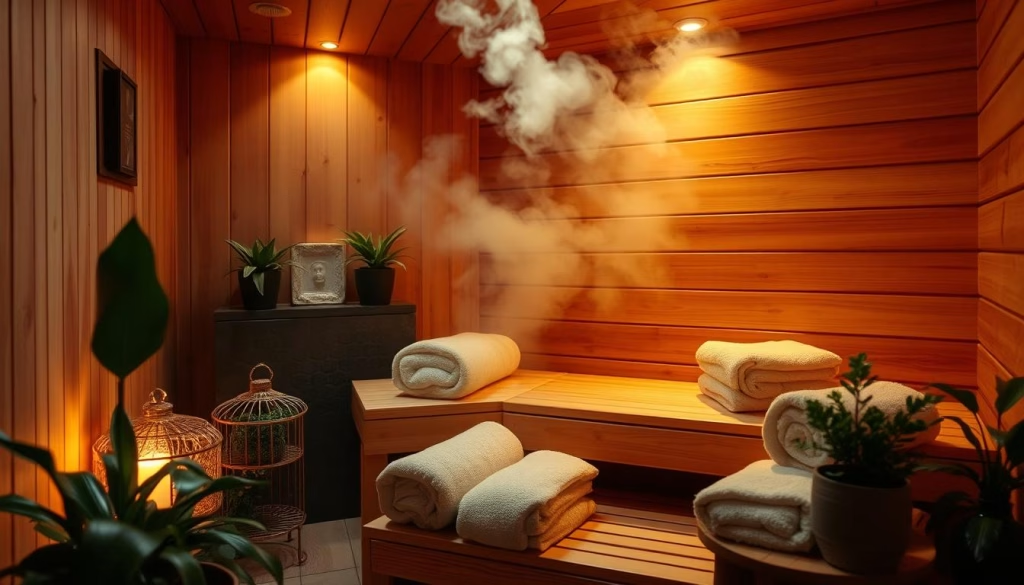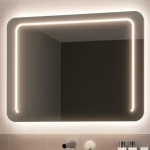Did you know sauna culture in Finland goes back to 7000 BC? It was more than just a place for cleaning. It was also key in religious events and social meetings. Today, a home sauna brings this relaxing feeling into your home. Imagine having a private sauna that offers comfort, renewal, and a break from daily stress.
Getting a home sauna means you can enjoy sauna benefits without the crowds. There are many styles and sizes, from small ones for 2 people to bigger ones for 8. This guide will show you the different saunas, their health perks, and how to set one up. You’ll learn about traditional and infrared saunas, and what accessories you need for the best experience.
Key Takeaways
- Sauna culture has deep historical roots, particularly in Finland.
- A home sauna provides personal space for relaxation and wellness.
- Different types of saunas cater to varied preferences and needs.
- Regular sauna use promotes numerous physical and mental health benefits.
- Creating the right ambiance enhances the overall sauna experience.
- Proper maintenance ensures longevity and optimal performance of your sauna.
Introduction to Home Saunas
Home saunas are becoming more popular for those wanting a personal retreat at home. They turn a part of your home into a place for relaxation and rejuvenation. You can enjoy the benefits of an indoor sauna, which helps with stress relief and well-being, all from your own home.
One great thing about home saunas is the privacy they offer. There are no strict rules or etiquette to follow, so you can enjoy your sessions freely. Having a sauna at home can also be a place where family and friends can relax together in a calm setting.
Home saunas come in various price ranges, from £3,000 to £15,000. The cost depends on the wood, heater, and design. Popular woods like cedar, spruce, and pine are durable and fit different tastes and budgets.

Electric heaters are the top choice for home saunas because they are easy to install and maintain. You can choose from traditional, infrared, and steam saunas, each offering different heating methods and efficiency levels. This means there’s a sauna for every homeowner’s needs.
The trend of home saunas is growing, offering a luxurious spa experience whenever you want. By embracing this trend, you can create a comforting space that benefits your body and mind, all in the privacy of your home.
History and Cultural Significance of Saunas
The sauna history goes back to around 2000 BC in northern Europe. Early saunas were key parts of daily life. In Finland, there are 3 million saunas, more than cars. This shows how important saunas are in Finnish culture.
At first, saunas were pits dug into slopes for warmth and shelter. Later, they became smoke saunas, or savusauna. These Finnish saunas could stay hot for up to 12 hours. They were used for many things, like kitchens and hospitals.
After World War II, German soldiers brought Finnish sauna traditions to Europe. This led to saunas becoming popular in Germany and Austria. Saunas were adapted to fit local customs, creating unique styles like the Russian banya and Estonian sauna.
Estonia has kept its sauna traditions alive, mixing them with modern touches. Saunas are still places for socializing and business talks. UNESCO recognized Estonian smoke saunas in 2013 and Finnish sauna culture in 2020. This shows their importance today.
The industrial revolution brought chimneys to saunas, making them warmer. In the mid-20th century, electric saunas became common. Today, Estonian craftsmen create modern saunas that blend old and new.

| Aspect | Details |
|---|---|
| Origins | Circa 2000 BC in Northern Europe |
| Modern Statistics | 3 million saunas in Finland for 5.5 million people |
| UNESCO Recognition | Estonian smoke sauna (2013) and Finnish sauna culture (2020) |
| Common Features | Social gatherings, hygiene, relaxation |
| Types | Finnish sauna, Russian banya, Estonian sauna |
Understanding Different Types of Saunas
Choosing a sauna means knowing the different types. Each offers unique benefits and experiences. We’ll look at traditional saunas, infrared saunas, and steam saunas.
Traditional Saunas
Traditional saunas, often called Finnish saunas, use wood, electric, or gas heaters. They get hot, reaching 150 to 195 degrees Fahrenheit. The air stays dry.
Wood-burning saunas give a real feel, great for groups. Prices start at $2,000 for basic models. Luxury ones can cost over $10,000. They’re known for relaxation and health benefits.
Infrared Saunas
Infrared saunas heat your body directly, not the air. They’re cooler, between 80 to 130 degrees Fahrenheit. They’re good for healing tissues.
Prices vary, from $2,000 to $12,000. They’re energy-efficient, making them a good choice for health goals.
Steam Saunas
Steam saunas have high humidity, almost 100%. They use a steam generator and are cooler. They’re good for people with breathing problems.
Prices range from $4,000 to $6,000. There are portable options under $100. Sauna-shower combos save space, costing $3,500 to $6,000.

| Type of Sauna | Temperature Range (°F) | Humidity Level | Average Cost |
|---|---|---|---|
| Traditional Sauna | 150 – 195 | Low | $2,000 – $10,000+ |
| Infrared Sauna | 80 – 130 | Low | $2,000 – $12,000 |
| Steam Sauna | 100 – 120 | High (close to 100%) | $4,000 – $6,000 |
Benefits of Using a Home Sauna
Using a home sauna regularly brings many benefits for your body and mind. It turns your home into a place of peace and healing. Learning about these benefits might make you want to use a sauna every day.
Physical Benefits
Saunas are great for your body. They help your blood flow better, carrying oxygen and nutrients. The heat makes you sweat, which helps remove toxins.
Infrared saunas, for example, can lower blood pressure in just 15 minutes a day for two weeks.
- Promotes enhanced collagen production, improving skin elasticity.
- Facilitates muscle recovery, with studies showing growth hormone levels rising after sauna sessions.
- Reduces muscle tension and soreness, leading to greater physical comfort.
Mental and Emotional Benefits
Saunas also help your mind. They create a calm space that can lower stress levels. Using a sauna 5 to 15 times a month can improve your mental health.
- Boosts mood and enhances overall mental clarity.
- Creates a meditative space, helping clear the mind of daily stressors.
- Aids in relaxation through the use of essential oils, enhancing the therapeutic experience.

Choosing the Right Home Sauna for You
When picking a home sauna, many things matter. The space you have and the materials used are key. These choices help fit the sauna to your life and home.
Consider Your Space
Start by looking at how much room you have. Think about:
- Size and Capacity: How many will use it at once affects size.
- Location: Where it goes matters for access, privacy, and power.
- Regulations: Local rules might impact where and how you install it.
Type of Wood for Construction
Choosing wood is crucial for both looks and function. Each wood type has its own benefits:
| Wood Type | Benefits | Considerations |
|---|---|---|
| Scandinavian Wood | Keeps heat well, lasts long, and smells nice. | Needs regular care to keep looking good. |
| Thermo Wood | Stays strong against moisture, lasts longer. | Costs more because of special treatment. |
| Wood-Fired Saunas | Gives a traditional feel. | Needs more upkeep, like chimney care. |
Quality materials are key for safety, saving energy, and comfort. By thinking about these points, you’ll create a cozy spot just for you.
Home Sauna Installation Process
Setting up a home sauna requires careful planning. You need to check electrical and plumbing needs and ensure good ventilation. Knowing what materials you need and how much space is required is crucial for a smooth installation.
Planning Your Sauna Room
First, pick the best spot for your sauna. It could be in a basement, closet, or even outside in a shed or on a deck. Think about these important points when planning:
- Space requirements: Make sure there’s enough room for your sauna and any extra features.
- Building codes: Check local laws to meet safety standards.
- Ventilation: Plan for good airflow to keep the space comfortable.
- Utilities: Having electrical outlets and plumbing nearby will make installation easier.
Sauna Kit Options
Deciding between a sauna kit or a custom build affects the installation. Sauna kits are easy to assemble and come with clear instructions. They fit different budgets and tastes. Here are some common types:
- Infrared sauna kits: Great for quick setup and save on energy.
- Traditional kits: Have wood frames and need more work to install.
- Barrel sauna kits: Stand out with their design and heat well.
Prices and features vary among sauna kits. For example, the Cala Glass Cabin costs $5,950 and looks modern. The SaunaLife G11, priced at $13,900, offers top-notch quality. The SaunaLife X2 and G2 are more affordable at $4,990 each. Choosing a kit makes the installation easier and creates a cozy spot at home.

Essential Sauna Accessories for the Ultimate Experience
Turning your home sauna into a place of peace needs more than just a good design. You’ll want to add sauna accessories to make it better. These items, from heaters to design pieces, boost both function and fun.
Sauna Heaters
Choosing the right sauna heaters is key for a great sauna time. They are the heart of the sauna, providing the warmth needed for relaxation. You can pick from electric, wood, or infrared heaters, matching your style and design.
It’s important to keep an eye on the temperature and humidity. Using thermometers and hygrometers helps you get the perfect setting. Adding water to heated stones, called löyly, makes the air steamy and improves the vibe.
Sauna Design Elements
The design of your sauna greatly affects your experience. Details matter a lot. Comfortable benches and backrests, made from strong wood, support you and make sitting longer enjoyable. Essential oils like eucalyptus and lavender add a calming scent.
Good lighting sets the mood for relaxation. LED lights and wooden shades in lamps change the atmosphere. Sauna headrests and towels, especially cotton and bamboo ones, add to the comfort, making longer stays nice.
Maximizing Your Sauna Experience
To enjoy a home sauna fully, focus on making your experience better. Good practices can boost relaxation and health benefits. Here are some tips to get the most out of each sauna session.
Tips for Optimal Usage
Timing and staying hydrated are key to using a sauna well. You can lose a lot of water in just 20 minutes, so drink water before and after. A warm shower before going in helps open pores and remove oils.
Keep sauna sessions short, about 15-20 minutes, at 160º-180ºF. Start with 5 minutes if you’re new, and increase as you get used to the heat. If you’ve been exercising hard, cool down first for safety.
Creating the Right Ambiance
The right atmosphere in a sauna makes it better. Use scented oils like lavender and chamomile for relaxation and muscle relief. Adjust the lights for a calm setting. Adding calming music can also improve your experience.
Try Löyly, throwing water on the sauna rocks, for a more immersive experience. It increases steam and makes the sauna feel more enjoyable.
Here’s a table with key tips for better sauna sessions:
| Tip | Details |
|---|---|
| Hydration | Drink water before and after to maintain optimal hydration levels. |
| Session Duration | Aim for 15-20 minutes at higher temperatures; start with shorter sessions for beginners. |
| Aromatic Enhancements | Add scented oils for relaxation and muscle soothing benefits. |
| Löyly Technique | Enhance heat perception by throwing water onto the sauna rocks. |
| Ambiance Control | Adjust lighting and sound for a relaxing environment. |
| Post-Sauna Cool Down | Gradually decrease body temperature after sessions for comfort. |
Maintenance and Care for Your Home Sauna
Keeping your home sauna in top shape is key to enjoying it for years. Regular upkeep boosts its performance and life span. Start with some essential habits.
- Wiping down surfaces after each use to cut down on moisture and bacteria.
- Checking heater functionality to avoid any performance problems.
- Using filtered or soft water to stop limescale from hard water.
For better sauna care, preheat it for at least 30 minutes before use. This step makes it hard for bacteria to grow. Also, keep doors and vents open after use to let moisture out.
Cleaning routines should include:
- Wiping down wooden surfaces with water and a mild detergent.
- Make sure no paint or sealants are on the wood. This lets it breathe and handle moisture.
- Do an annual check for wear or damage, especially on wood and electrical parts.
Don’t forget the heater. Clean and re-stack the heater stones to keep airflow and steam quality good. Replace any yellowed or crumbling stones for better efficiency.
By sticking to these sauna maintenance and care tips, your sauna will last longer and feel more comfortable.
Conclusion
Getting a home sauna can greatly improve your health. It helps with blood flow, muscle ease, stress relief, and detox. These benefits make a sauna a great reason to have one at home.
Choosing the right sauna is key. You might prefer a traditional Finnish sauna or an infrared one. Each has its own benefits.
It’s important to install and maintain your sauna well. This keeps it a place of peace and health. Modern saunas, made from cedar and hemlock, also add beauty to your home.
Adding a sauna to your home can change your life. It offers a space for relaxation and healing. Start your wellness journey with a home sauna today.
FAQ
What are the benefits of having a home sauna?
A home sauna can improve your circulation and relax your muscles. It helps detoxify your body and reduces stress. It also boosts your mental health and supports your heart and immune system.
How do I choose the right type of sauna for my home?
Think about the space you have and what benefits you want. Traditional saunas use high heat and low humidity. Infrared saunas heat your body directly, and steam saunas are humid. Choose based on your comfort and health goals.
What should I look for in a sauna kit during installation?
Look at the materials, size, and accessories in the sauna kit. Make sure it has clear installation instructions. This will help you set it up easily.
How can I enhance my sauna experience?
To improve your sauna time, use good heaters, lights, and seats. Adding aromatherapy, sound systems, and temperature control can make it more personal and enjoyable.
What is the recommended maintenance for a home sauna?
Keep your sauna clean, check the heater, and manage humidity. Good ventilation is also important. Use the right cleaning products to keep the wood and sauna in good shape.
Are there any specific sauna accessories I should consider?
Important accessories include heaters, thermometers, and hygrometers. Seating pads are also key. Towel racks and wellness products can add to your experience.
How often should I use my home sauna for optimal benefits?
For best results, use your sauna 2-3 times a week for 15-30 minutes. Listen to your body and adjust as needed.
Can I install a sauna in limited space?
Yes, you can fit a sauna in small spaces. Measure your area carefully to choose the right size sauna kit.
What type of wood is best for a sauna?
Cedar, hemlock, or thermo wood are top choices for saunas. They retain heat well and last long, enhancing your sauna experience.
Source Links
- Saunas and heat therapy: an ultimate guide – Dröm UK
- Sauna | Premium quality | Free delivery | Polhus UK
- 1 Person Infrared Sauna Selection
- HOME sauna: Your perfect introduction to the sauna world – KLAFS
- Build a Sauna at Home: What You Need to Think About | Leisurequip
- Here’s why the history of the sauna is deeper than you might think
- The 10,000-year-old origins of the sauna – and why it’s still going strong
- Sauna
- 5 Steamy Types Of Saunas
- Types of Saunas: A Comprehensive Guide To Finding The Ideal Sauna
- 9 Reasons Why Having a Home Sauna is Worth it
- 5 Benefits of a Home Sauna
- Polhus | Choose your best home sauna | Polhus
- Choosing the Right Sauna for Your Home
- How To Build a Sauna
- Everything You Need to Know About Preparing for an In-Home Sauna Installation
- Sauna Accessories: Essential Add-ons for the Ultimate Experience
- Luxury Sauna Accessories | UK Saunas
- Enhance Your Sauna Experience with These Must-Have Accessories
- 15 Sauna Tips to Revolutionise Your Sessions
- How to Take A Sauna Session to the Next Level
- 12 Tips To Get The Most Out Of Your Sauna Experience
- 7 Essential Tips For Sauna Maintenance
- Sauna Maintenance; Ultimate Sauna Care Guide – Neptune Saunas
- All About Home Sauna | Royal Tubs
- Discover the Health Benefits of Adding a Traditional Sauna to Your Bathroom Renovation – Design for Me






